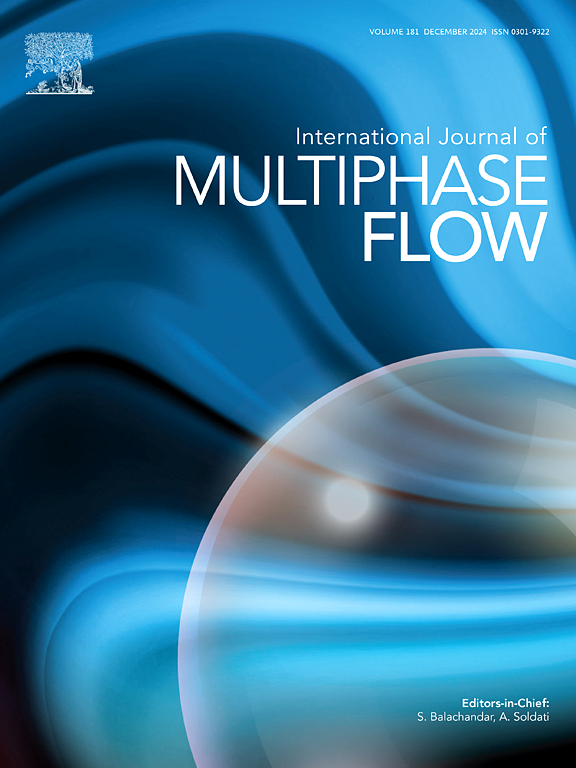Experimental investigation of flash-boiling ethanol-R-152a sprays
IF 3.6
2区 工程技术
Q1 MECHANICS
International Journal of Multiphase Flow
Pub Date : 2025-06-10
DOI:10.1016/j.ijmultiphaseflow.2025.105329
引用次数: 0
Abstract
Flash-boiling (flashing) sprays are characterised by explosive atomization generated by a superheated fluid exiting an orifice. This mechanism modifies spray structure and exhibits strong coherent structures. This study investigates the impact of flashing on spray atomization using high-speed imaging on near-nozzle sprays at 100,000 frames per second. The Jakob number (Ja) was varied by adjusting the degree of superheat while holding Weber (We) and Reynolds (Re) numbers near-constant to explore the effects on droplet atomization at the onset of flashing. Time-averaged analysis showed changes in spray morphology and spreading rate, while spectral analysis and a data-based modal decomposition technique provided insights into spray transient behaviour and structure. For Ja values greater than 0.2, spray profiles became more homogeneous, with reduced variability and increased stability in flashing flow. Flash-boiling flow is least stable when in an intermittent state. Flash evaporation suppressed high-frequency content (Strouhal number Str > 10−2), amplified low-frequency magnitudes, enhanced pre-existing flow instabilities and altered the instability structure, producing chevron-shaped waves. For this reason, decreasing Ja could affect injection systems or medical inhaler spray performance. Further investigation is needed to fully understand the complex dynamics of flashing sprays.
快沸乙醇- r -152a喷雾剂的实验研究
闪沸(闪)喷雾的特点是由从孔口流出的过热流体产生爆炸雾化。这一机制改变了喷雾结构,呈现出较强的连贯结构。本研究利用10万帧/秒的近喷嘴高速成像技术研究了闪烁对喷雾雾化的影响。在保持韦伯数(We)和雷诺数(Re)接近恒定的情况下,通过调整过热度来改变Jakob数(Ja),以探索闪烁开始时液滴雾化的影响。时间平均分析显示了喷雾形态和扩散速度的变化,而光谱分析和基于数据的模态分解技术则提供了对喷雾瞬态行为和结构的深入了解。当Ja值大于0.2时,喷雾轮廓变得更加均匀,在闪蒸流动中变异性减少,稳定性增加。在间歇状态下,闪沸流最不稳定。闪蒸抑制高频含量(斯特劳哈尔数Str >;10−2),放大了低频震级,增强了原有的流动不稳定性,改变了不稳定性结构,产生了线形波。因此,降低Ja可能会影响注射系统或医用吸入器的喷雾性能。需要进一步研究,以充分了解闪烁喷雾的复杂动力学。
本文章由计算机程序翻译,如有差异,请以英文原文为准。
求助全文
约1分钟内获得全文
求助全文
来源期刊
CiteScore
7.30
自引率
10.50%
发文量
244
审稿时长
4 months
期刊介绍:
The International Journal of Multiphase Flow publishes analytical, numerical and experimental articles of lasting interest. The scope of the journal includes all aspects of mass, momentum and energy exchange phenomena among different phases such as occur in disperse flows, gas–liquid and liquid–liquid flows, flows in porous media, boiling, granular flows and others.
The journal publishes full papers, brief communications and conference announcements.

 求助内容:
求助内容: 应助结果提醒方式:
应助结果提醒方式:


